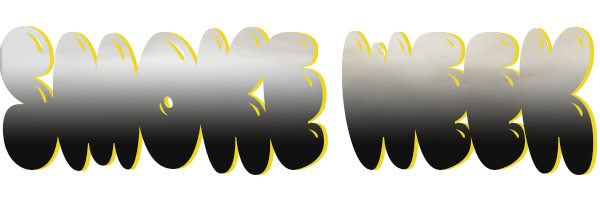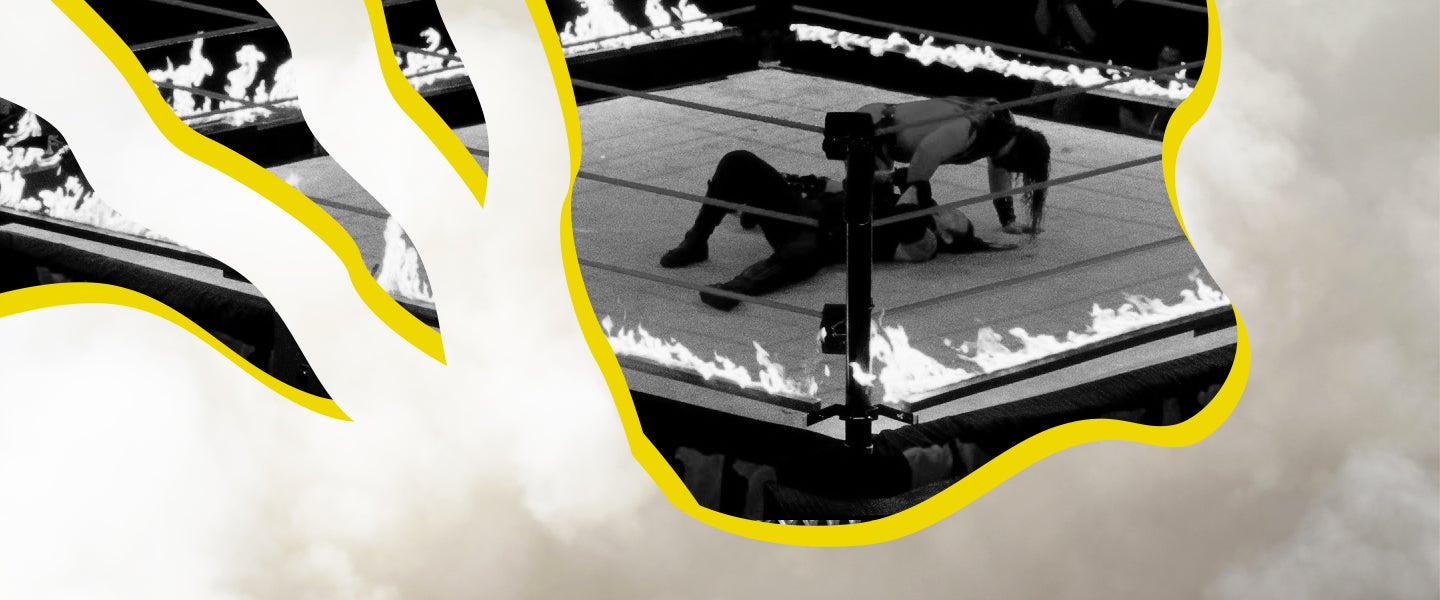
We’re such stoners that 4/20 isn’t just a day, it’s an entire week. And it’s not just weed we love, it’s the act of smoking and everything even loosely related to breathing in toxic fumes — whether that’s chain-smoking cigarettes, vaping Juuls, suffocating a rack of ribs, or hell, even committing arson! Welcome to our exploration of all things smoke.
If you watched Last Week Tonight host John Oliver’s recent shaming of the WWE for its poor working conditions — something the national media feels obligated to report on every five years or so — then you got to see some vintage footage of “Rated R Superstar” Edge spearing a bloodied Mick Foley through a burning table at WrestleMania 22. In one of the segment’s brief positive moments, Oliver went on about how this move underscored wrestling’s underlying awesomeness. But for the wrestlers themselves, how awesome is it to go through a table that had been set on fire?
“It’s not awesome at all because it’s really hard to set it up and it’s really hard for the crew to get in place to shoot it safely,” says “Reptile,” a cameraman who works for wrestling promotions such as Pro Wrestling Guerilla, Juggalo Championship Wrestling and Ring of Honor. “But it’s something that’s still being done sometimes to ‘put over’ a big match, like when Cody Rhodes ended his feud with Christopher Daniels back in 2017 by powerbombing him off the top rope onto a burning table. It was definitely something people talked about.”
This chapter of my career with @facdaniels has been full of surprises and I am better for it.
It ended tonight. Thank you Dallas. pic.twitter.com/amvLutG6Ld
— Cody Rhodes (@CodyRhodes) November 19, 2017
Pro wrestling has a long history of using fire to enhance its spectacle. Ed Farhat, “the Original Sheik,” infuriated Detroit spectators throughout the 1960s and 1970s by hurling fireballs at the hapless good guys who came to Cobo Hall to try to win his United States championship. Jerry “The King” Lawler, ostensibly a good guy when he was wrestling in Memphis during the 1970s and 1980s, nevertheless threw fire at the likes of Kamala the Ugandan Giant and a host of other ne’er-do-wells. The results were immediate and consequential: Even if the fireball didn’t come within five feet of the victim, they were required to writhe on the ground as if they’d been struck by a bolt of lightning.
“Most fire tricks are actually fairly harmless,” says Edward Reiner, who worked as an assistant director on a series of B movies during the late 1990s. “You can pick up the bare bones from watching instructional videos on YouTube, or like when I was a kid, just finding out who was the neighborhood firebug and going out to burn stuff with him. Of course, on a film set you’ve got IATSE technicians and the related union-mandated protections there. And you’re not just hiring the neighborhood firebug, but instead people who have been doing this for a career, so the conditions are controlled.”
Falling onto tables, where a blaze has been set in advance in preparation for the high spot, however, can be much trickier. “Let’s say you’re dousing the table with Ronsonol lighter fluid, like you see in backstage wrestling,” says Reptile. “The challenge for the crew is going to be pretty simple — what if the spot takes a long time to execute? You need to get a decent amount of fire going. If it’s outside and the wrestler takes too long to throw the guy onto the table, the flame can go out and he’ll look stupid. And in a legit hardcore match people are always moving slowly because they’re so beat up, recovering from walking on fluorescent bulbs or thumbtacks or whatever.”
“Staging? There’s not much staging,” says Danny Cage, the operator of the Monster Factory wrestling school in New Jersey. “You just do the stunt and hope you don’t get hurt. It’s not rocket science.”
“If you’re falling into a heap on a burning table, your momentum ought to extinguish the fire,” adds Reptile. “Come down fast, land flat on your back and the table should go out. You might get singed a little bit, but that’s the basics of it.”
The precise origins of hardcore wrestling’s incorporation of fire are hard to pin down. People like The Sheik and Lawler had used fireballs as part of their shtick for a long time, and neither was afraid to bleed or take hard shots from a steel chair if the match called for it. However, most trace the normalization of the practice — as normal as in-ring pyromania can ever be — to Japanese wrestler Atsushi Onita’s Frontier Martial-Arts Wrestling (FMW) promotion. In fact, by the early 1990s, the stocky, mullet-sporting Onita was wrestling inside rings surrounded by electrified barbed wire and filled with explosive charges.
“Onita was unique in that he could maintain a pretty good pace while getting all cut up and burnt up,” says Reptile. “He was special that way. Mick Foley over in the IWA [International Wrestling Association of Japan, a rival to FMW] worked a pretty good pace when he was in their King of the Deathmatch events in the mid-1990s. IWA had a lot of good bleeders and burners back then. You were seeing a lot of the use of these mild plastic explosives in the match, and Terry Funk started doing a gimmick where he set chairs and branding irons on fire. There was just a lot of upping of the stakes at the time to see who was the bloodiest and baddest, but it could get slow and boring if the guys got cut up too badly.”
Reptile cut his cinematographic teeth, metaphorically speaking, while ringside at Extreme Championship Wrestling events during the mid-1990s. “I was taking photos with disposable cameras from back in the stands. ECW was pretty much always in Philly, where I grew up, and it was a cheap ticket. This is where you had Funk and Foley hitting each other with burning furniture. Where you had fat blobby guys rubbing their hands in glue and glass and then bitch-slapping each other until the ring was filled with buckets of bloods. Then you had the Dudley Boyz, a gimmick that kind of evolved from a stable of nitwits to a core of Bubba Ray [Bully Ray in Ring of Honor] and D-Von Dudley, with little Spike Dudley as a whipping boy, who were big on the table gimmick. The tables were so over, just the thought of people falling through them, and they were always upping the ante with the tables.”

In Reptile’s opinion, the flaming table came to be regarded as a quintessentially Dudley Boyz stunt. “When they dragged tables out to the ring and fell through them or put people through them, the crowd went apeshit. It was pure gold. There was a hunger for it. So setting tables on fire was a natural progression because, like I said, it’s not too bad a stunt, when you get right down to it. The setup can take a long time, but the effect won’t be too bad if you land fast enough to hopefully put out most of the fire. You can roll a little to get rid of the rest of the flames. Throwing Spike Dudley down, because he was so little, was a great idea, because he’d produce this huge breeze.”
Reiner, who hadn’t ever watched much wrestling, was aghast when shown footage of Spike Dudley and Mick Foley going through flaming tables. “The Foley fall is big budget, but it’s so slow and stupid, because he’s hanging on the ring apron for like five minutes. You wonder which spectators would find this believable,” he says. “It’s like the crowd is waiting on a silly stunt they know is going to happen. It’s stupid, but at least it’s WWE and there’s probably competent safety personnel on hand. This other stuff is scary, and totally unsupervised. Like think about it: People’s entire careers are spent becoming licensed special-effects operators, where they’re trained to do these non-CGI effect shots under safe, controlled circumstances. But in small-time pro wrestling, you can just have two fat guys lighting a table on fire with a squeeze bottle of Ronsonol and then falling on it. That’s really something, but hey, it’s a free country.”
When pressed for his own opinion about the flaming table spot, Reptile waxes philosophical. “These days, I shoot what I’m paid to shoot,” he says. “Even with flaming tables still appearing from time to time [like in that recent Cody Rhodes match against Christopher Daniels] the fans are way more educated in terms of wanting an athletic and safe match than back in the late 1990s. We as camera crew are trained to get in there and hit the right shot on the right spot, to follow along with that type of chain-move oriented pacing. That’s what you see in Ring of Honor or NXT nowadays.”
That said, the flaming table spots of yore will always hold a place in Reptile’s heart. “My better-paying current employers don’t even want me talking to you about this, because they’re trying to downplay it and play up athleticism and sportsmanship and how safe and well-treated the wrestlers are,” he says. “But just like wearing the crimson mask, or getting juice — it’s part of the history and art of the sport. You put your opponent through a flaming table, nine times out of 10, he doesn’t kick out. That’s the end. And if he does kick out, well, that means he’s going through two or three more flaming tables.”
“That’s wrestling logic,” Reptile continues, “and there’s a finality to it from a storytelling standpoint. Your feud with your hated enemy has just gone up in smoke. Extinguishing the flames is the ultimate blow-off, in a way.”

